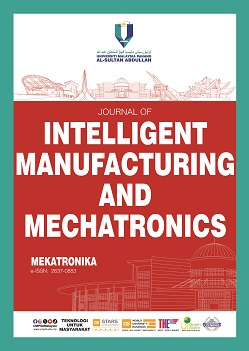Numerical Simulation of Thermal Comfort in Passenger Car Compartment Using CFD-Heat Transfer Coupling
DOI:
https://doi.org/10.15282/mekatronika.v6i1.10212Keywords:
Thermal Comfort, Hyperthermia, HVAC, CFD, Bio-heat transferAbstract
While heating, ventilation, and air conditioning (HVAC) systems provide thermal comfort for the car occupants, the passenger compartment’s thermal environment is not uniform and needs to be further assessed. Different cars have different car compartment designs too, thus, the distribution of the airflow and temperature field inside the passenger compartment has to be examined so that improvements in the different car designs can be proposed. Hence, this study aims to investigate the thermal comfort in a Malaysian local brand sedan car which is Proton Saga FLX 2012 using the coupling of computational fluid dynamics (CFD) and heat transfer. A simplified human model was included in the car to allow the understanding of the effect of airflow and temperature field distribution on the passengers sitting under ventilation system conditions. A few conditions also were simulated; without outlets where all windows close (Case 1) and with different window openings (Case 2). The thermal comfort of the passengers was analysed based on the temperature or thermal field displayed on the human models. The head, hand, torso, feet and overall temperature were evaluated. The results showed that in the no outlet condition when all windows were closed, air conditions were on and the initial compartment temperature was at 50°C, it can cause hyperthermia stage to humans. Besides, the hands will have the lowest body temperature in both situations with and without window openings because it is directly facing the air-conditioning. In addition, window opens have pleasant air velocity compared to those without windows open.
References
Holmer I, Nilsson H, Bohm M, Noren O. Thermal aspects of vehicle comfort. Applied Human Science. 1995;14(4):159-65.
Satinoff E, Hendersen R. Thermoregulatory behavior. Handbook of operant behavior: Routledge; 2022. p. 153-73.
Luo M, Xu S, Tang Y, Yu H, Zhou X, Chen Z. Dynamic thermal responses and showering thermal comfort under different conditions. Building Environment. 2023;237:110322.
Ravindra K, Agarwal N, Mor S. Assessment of thermal comfort parameters in various car models and mitigation strategies for extreme heat-health risks in the tropical climate. Journal of Environmental Management. 2020;267:110655.
Leon LR, Bouchama A. Heat stroke. Compr Physiol. 2011;5(2):611-47.
Worfolk JB. Heat waves: their impact on the health of elders. Geriatric Nursing. 2000;21(2):70-7.
Leon LR, Helwig BG. Heat stroke: role of the systemic inflammatory response. Journal of Applied Physiology. 2010;109(6):1980-8.
Bouchama A, Abuyassin B, Lehe C, Laitano O, Jay O, O’Connor FG, et al. Classic and exertional heatstroke. Nature Reviews Disease Primers. 2022;8(1):8.
Booth JN, Davis GG, Waterbor J, McGwin G. Hyperthermia deaths among children in parked vehicles: an analysis of 231 fatalities in the United States, 1999–2007. Forensic Science, Medicine, and Pathology. 2010;6:99-105.
Yousef H, Ramezanpour Ahangar E, Varacallo M. Physiology, thermal regulation. StatPearls. 2022.
McLaren C, Null J, Quinn J. Heat stress from enclosed vehicles: moderate ambient temperatures cause significant temperature rise in enclosed vehicles. Pediatrics. 2005;116(1):e109-e12.
Ahad R, Rosli NS, Mustafa MZ. Child Presence Detection Car Alarm System using GSM. Research Innovation in Technical Vocational Education Training. 2021;1(2):028-41.
Simion M, Socaciu L, Unguresan P. Factors which influence the thermal comfort inside of vehicles. Energy Procedia. 2016;85:472-80.
Bandi P, Manelil NP, Maiya M, Tiwari S, Thangamani A, Tamalapakula J. Influence of flow and thermal characteristics on thermal comfort inside an automobile cabin under the effect of solar radiation. Applied Thermal Engineering. 2022;203:117946.
Siddiqui SA, Siddiqui GF, Singh MV. Vehicular hyperthermia deaths in Indian children: a little recognised mode of fatal injury. Tropical doctor. 2021;51(1):109-11.
Khatoon S, Kim M-H. Thermal comfort in the passenger compartment using a 3-D numerical analysis and comparison with Fanger’s comfort models. Energies. 2020;13(3):690.
Dixit A, Gade U. A case study on human bio-heat transfer and thermal comfort within CFD. Building Environment. 2015;94:122-30.
Khatoon S, Kim M-H. Human thermal comfort and heat removal efficiency for ventilation variants in passenger cars. Energies. 2017;10(11):1710.
Currle J, Maué J. Numerical study of the influence of air vent area and air mass flux on the thermal comfort of car occupants. SAE Technical Paper; 2000. Report No.: 0148-7191.
Alahmer A, Mayyas A, Mayyas AA, Omar M, Shan D. Vehicular thermal comfort models; a comprehensive review. Applied Thermal Engineering. 2011;31(6-7):995-1002.
Li J, Cao X, Liu J, Mohanarangam K, Yang W. PIV measurement of human thermal convection flow in a simplified vehicle cabin. Building Environment. 2018;144:305-15.
Hubakri MF, Zamri MAS, Hamzah MNA, Roslan RA, Wan Ab Naim WN, Mohamed Mokhtarudin MJ. Design and development of a flexible test rig for biomedical engineering PIV experiment. Enabling Industry 40 through Advances in Manufacturing and Materials: Selected Articles from iM3F 2021, Malaysia: Springer; 2022. p. 99-107.
Downloads
Published
Issue
Section
License
Copyright (c) 2024 The Author(s)

This work is licensed under a Creative Commons Attribution-NonCommercial 4.0 International License.




